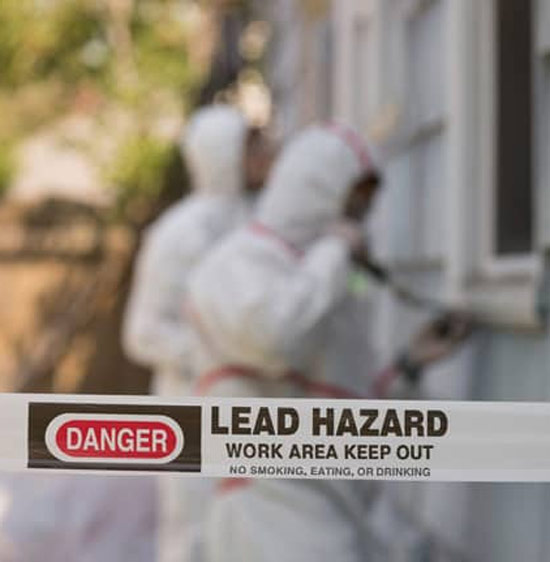Comprehensive Overview on Effective Lead Infraction Elimination Strategies
In the world of ecological security, resolving lead offenses requires a thorough and structured method. This comprehensive guide starts by highlighting the crucial first steps of recognizing lead threats via advanced analysis and testing methods. The guide specifies on the value of adhering to rigid safety procedures throughout the removal procedure, including the usage of proper PPE and separating affected locations.
Determining Lead Threats
Determining lead threats is a critical very first action in alleviating the threats related to lead direct exposure. Lead, a toxic steel, can be existing in various environmental tools, including paint, soil, water, and dirt. It postures severe health and wellness risks, especially to kids and expectant women, causing neurological damages and developmental delays. Specific identification of potential lead sources is crucial for reliable remediation.
The first phase in identifying lead dangers includes understanding common lead resources within the developed setting. Structures constructed prior to 1978 are especially prone due to the widespread use lead-based paint throughout that duration. In addition, dirt contamination can happen from wearing away outside paint, commercial exhausts, or historic use of leaded gasoline.
Another significant resource is lead piping and plumbing fixtures, which can leach introduce drinking water. Consumer goods such as playthings, ceramics, and imported items may additionally have harmful lead levels. Especially, job-related atmospheres and pastimes including lead can track contaminants right into homes.
Analysis and Testing
When dealing with lead hazards, effective assessment and screening are extremely important. This essential step ensures the recognition and quantification of lead visibility, therefore assisting subsequent removal efforts. First evaluation generally involves an aesthetic evaluation to recognize prospective lead sources, such as wearing away paint or polluted dirt. This is matched by even more extensive screening methods to determine the level of contamination.

Dirt wipe sampling is one more critical strategy, particularly in domestic setups. By accumulating examples from floorings, windowsills, and other surface areas, this approach gives insights into prospective exposure dangers. In addition, soil testing around structure borders is important to spot lead contamination that might present threats, specifically to youngsters.
Safe Elimination Procedures
Upon completing complete evaluation and testing, executing risk-free removal procedures is the following essential stage in attending to lead threats. This procedure ensures that lead-contaminated products are efficiently and safely eradicated, decreasing threat to both employees and homeowners. The initial step includes isolating the damaged location utilizing plastic sheeting and correct securing strategies to avoid the spread of lead dirt.
Workers must wear proper personal protective tools (PPE), including respirators, handwear covers, and non reusable coveralls, to reduce exposure. Using specialized tools and wet approaches, such as wet fining sand or utilizing HEPA-filtered vacuums, lowers the dispersion of lead particles. It is critical to prevent dry fining sand or abrasive blowing up, as these methods can create dangerous lead dirt.
Garbage disposal is another essential element; all infected materials have to be safely landed and identified according to EPA and neighborhood policies. In addition, extensive cleansing of the work area with HEPA vacuum cleaners and damp cleaning makes certain the elimination of residual lead fragments.
Post-Removal Verification

Verification of successful lead removal, referred to as post-removal verification, is necessary to guarantee the safety and habitability of the this article remediated area. This procedure involves a series of careful analyses and tests created to spot any type of recurring lead particles that may position wellness threats. The first action usually consists of an aesthetic inspection to assess the completion and high quality of the removal job. This examination makes sure that all recognized resources of lead have actually been resolved which no noticeable signs of contamination remain.
Following the visual examination, ecological tasting is performed. This includes gathering dust, soil, and sometimes water samples from the remediated location. Approved research laboratories examine these samples to measure lead levels, guaranteeing they drop below the safety thresholds developed by regulative bodies such as the Environmental Security Company (EPA)
Additionally, air top quality screening may be performed to spot air-borne lead fragments, particularly in instances where comprehensive lead-based paint elimination or improvement has occurred. The results of these tests give quantitative data validating that the lead levels are within permissible restrictions.
Eventually, post-removal confirmation works as an important checkpoint, verifying the effectiveness of the lead reduction efforts and guarding the health and wellness of occupants and site visitors.
Safety Nets and Maintenance

A crucial preventive procedure consists of the use of lead-safe licensed specialists for any remodelling, repair service, or paint activities. These specialists are trained in methods that minimize lead dust and particles. Additionally, preserving coloured surfaces to stay clear of chipping or peeling is crucial, as weakening paint can launch lead fragments into the atmosphere.
Educational campaigns Clicking Here targeting home owners and occupants regarding the dangers of lead and the value of reporting any kind of possible hazards can even more improve preventative initiatives. Regular cleansing using HEPA vacuums and wet mopping methods can significantly reduce lead dust build-up.
Final Thought
In summary, effective lead infraction removal requires a thorough method incorporating comprehensive assessment, accurate screening, and strict elimination procedures. Ongoing examinations and upkeep are essential to minimize future lead risks, consequently securing public health and important source wellness and making certain sustained compliance with governing requirements.